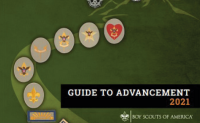 You say to-may-to, I say to-mah-to. You say Venture, I say Venturing. Which is correct?
You say to-may-to, I say to-mah-to. You say Venture, I say Venturing. Which is correct?
Many times we find ourselves writing about Scouting, either for our own units or for outside purposes. Whether writing a memo to your unit’s families, sending an e-mail to a community organization, or composing an article for the local newspaper, getting your words right is of high importance. It’s especially important at this time of year when many units are recruiting new members.
BSA has a section on its website called The Language of Scouting. Â This reference is used by BSA’s marketing and communications staffs to ensure that terms and language are used correctly and consistently. When we, as volunteers, misuse the terminology, Â it can result in us unwittingly making the organization look bad, can confuse readers, and possibly lead people astray in their search for information.
The site includes a glossary of Scouting terms, from Able (the second-highest rank in Sea Scouts) to youth-serving executive (a professional who serves at the unit level), along with their definitions and usage. Â Many terms are listed to show their hyphenation and capitalization as well.
Just as when we encounter a question about the program that’s best answered not by relying on what we’ve heard but rather by looking it up in the appropriate handbook, when we write about Scouting we should always check to make sure our use of the terms and language is consistent with the National Council’s style, definition and usage. Keep The Language of Scouting in your bookmarks and use it often.
Here are a few terms that I see misused or misspelled frequently:
- A unit in the older-youth program of the BSA is not a “Venture Crew” or a “Venture Scout Crew” but rather a Venturing Crew, and its members are not “Ventures” or “Venture scouts”  but Venturers. The term venture refers to high-adventure activities for a patrol of boys age 13 and up in a Boy Scout troop – a Venture patrol.
- The top leader in a Cub Scout Pack is not the “Packmaster” – it’s the Cubmaster (not “Cub Master” either). Likewise, Scoutmaster, not “Scout Master.”
- In the young-boy program, there are dens which comprise a pack – a Cub Scout pack, not a “Boy Scout pack”. They are part of the Boy Scouts of America, but neither the unit nor its members are Boy Scouts yet. You only capitalize “pack” or “den” when used with its number, such as Cub Scout Pack 54. (The same applies to troops and crews.) And, take care to avoid confusing the den number with the pack number. (I’ve seen mangled terms like “Wolf Boy Scouts of Cub Scout Den Pack 567” in the paper, undoubtedly written by a volunteer or parent who was unclear on the terminology.)
- The advanced training course for adults is Wood Badge (2 words, each capitalized), not “Woodbadge.” You wouldn’t believe how many actual course items I’ve seen (and have) that get that wrong.
- Of course, one of my biggest peeves is misuse of Webelos. The term means WE’ll BE LOyal Scouts (though if you’re old enough, you remember the Cub Scout rank progression Wolf Bear Lion Scout, where the term probably originated).  It is always used as an adjective, never as a noun – such as Webelos Scout, Webelos den, Webelos den leader – and is never used singularized, e.g. “Webelo” or “Weblo”. And we never, never call them “Weebs”!
- There is no rank of “Webelos I” or “Webelos II”, either. All Cub Scouts in fourth and fifth grades are Webelos Scouts. They may belong to a fourth-grade or a fifth-grade Webelos den, but they are all of the same rank. Furthermore, Webelos dens are not patrols, even though they may adopt an emblem and name similar to a Boy Scout patrol. Note: Effective in June 2015, the second-year portion of Webelos takes on the Arrow of Light moniker, as in ‘Arrow of Light den’.
- In a similar vein, it’s always Tiger Cub den, not merely Tiger or Tigers, and its members are Tiger Cubs, not “Tiger Scouts.” Note: Effective in June 2015, ‘Cub’ is dropped and they’re called Tigers.
- I’ve even seen this one misused by councils: It’s always Chartered Organization, not “Chartered Partner,” and not “Chartering Organization.” (The chartering organization is the Boy Scouts of America!)
- No hyphens are used in terms like fundraiser, cookout and campout, even though most spelling checkers find fault with these.
- Positions such as quartermaster and scribe are youth positions in a troop. Committee members and those in a Varsity team or Venturing crew who serve similar functions have titles like Equipment Coordinator and Secretary.
The best advice? It’s right there, too: KISMIF – Keep it simple; make it fun!
Image: Gregory Szarkiewicz / FreeDigitalPhotos.net
This post first appeared on Bobwhite Blather.




Here’s an example of misuse of the terminology even in official BSA publications. The link takes you to the article on fiscal policies for units put out by the National Council. In it, they refer to “chartering organization,” “sponsoring organization,” and “chartering partner” in addition to the correct usage of chartered organization.